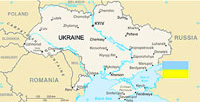Ukraine – some scenarios

(Business New Europe – bne.eu – Tim Ash, Standard Bank – March 20, 2014)
Ukrainian debt has been rallying over the past 24H which seems to reflect a number of factors:
– Optimism over an IMF deal likely to be announced later in the week likely Friday. With the assumption being that if the West has not the stomach to sanction Russia for its actions in Crimea it will try and sweeten the pill with a more generous aid package note herein comments from Swedish officials that they will provide additional bilateral loans to Ukraine.
– The assumption of no PSI, at least in the first iteration of any IMF support for Ukraine not to say that this could not follow soon after any initial agreement around multilateral/bilateral support, depending on how the domestic political and security setting evolves, e.g. further Russian intervention and the break up of Ukraine.
– In a similar vein to the above, the assumption that the EU tries to give Ukraine an extra whiff of some carrot by signing the political aspects of the Association Agreement also on Friday, and offering Ukraine an actual EU membership perspective.
– Fourth, evidence that Ukraine is negotiating for the withdrawal of its troops from Crimea, which would at least reduce one potential point for conflict.
Whether the above rally continues and ultimately whether Western support for Ukraine and the Maidan administration in Kyiv proves successful will depend on the relationship with Russia, and Moscow’s broader strategy towards Ukraine. Herein, I see two broad strategies from Moscow aimed at delivering on its bigger picture objectives still to veto/stop Ukraine’s EU integration, and ultimately to move Ukraine back into its orbit via the CIS CU/Eurasian Union which is part and parcel of a Greater Russia policy.
Scenario A: The long(er) Game
Under this scenario Russia bides its time with the annexation of Crimea, and does not move into Eastern Ukraine at this juncture. Moscow does though move to make life difficult for the new Maidan/Yatseniuk administration wherever possible. This will likely entail support for secessionist forces still in Eastern Ukraine, the likely imposition of trade restrictions across its borders with Ukraine, and likely proving difficult over debt/gas issues. The aim will be also to push for the creation of a coalition government in Kyiv, or victory for a Regions’ candidate in the May 25 presidential election to ensure no EU integration and no Western orientation. The assumption is that the Yatseniuk/Maidan administration will inevitably fail under these circumstances, allowing for Ukraine to finally be subsumed in the CIS CU/Eurasian Union at some point over the relatively near term. Under this scenario Russia does not give up yet on the aim of bringing the whole of Ukraine back under the Russian orbit.
Scenario B: Direct intervention The “State of Russia” scenario.
Under this scenario Moscow uses the weakness of the Yatseniuk administration and its defence capability and the similar weakness of the West, as reflected in the lack of any meaningful response to the annexation of the Crimea, to embark on a sustained military incursion into Eastern and Southern Ukraine. This could perhaps cut off the rump Maidan Ukraine’s access to the sea, hence making it economically unsustainable over the longer term. The aim would be to subsume areas of Ukraine with large ethnic Russian populations. This could also extend to Trans-dniestr in Moldova, creating an enlarged Greater Russia. The example would perhaps be how the State of Israel used the Arab wars in the 1960s and 1970s to expand territorially, and to create sufficient security buffer zones around its existing territorial mass. Support at home for such a strategy would likely be strong given current jingoistic messaging across the state media, while Putin enjoys very significant popular backing (>70%). The assumption (in Moscow at least) would be that this would generate little, if any, response from the West. Any such move would likely happen, sooner rather than later, given the current opportunity from the weakness of its rivals. Pretexts for such intervention could be demonstrations/unrest in cities in Eastern and Southern Ukraine, or perceived threats to the rights of ethnic Russians, or even the signing of the political aspects of the AA with the EU this Friday.
Suffice to say either of the above scenarios presents very sizeable threats on any Ukrainian administration see recent IIF report on the potential fallout. I guess another more optimistic scenario can be painted where the Maidan administration succeeds, against all the odds, despite Russian pressures, and reforms, succeeding in transforming Ukraine akin to how the Saakashvili administration transformed Georgia after the Russian invasion of 2008. Russian pressure rallies the nation behind reforms, and the West pumps money into Ukraine to ensure the country’s success. The latter seems a tough ask, given the intensity of Russia’s actions thus far, and the relatively low level of support delivered from the West.
